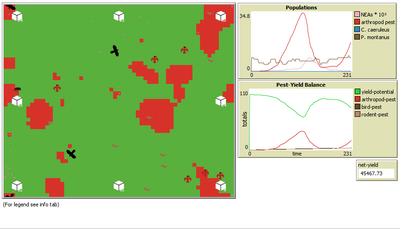Avian pest control: Yield outcome due to insectivorous birds, falconry, and integration of nest boxes. (1.0.0)
The model aims to simulate predator-prey relationships in an agricultural setting. The focus lies on avian communities and their effect on different pest organisms (here: pest birds, rodents, and arthropod pests). Since most case studies focused on the impact on arthropod pests (AP) alone, this model attempts to include effects on yield outcome. By incorporating three treatments with different factor levels (insectivorous bird species, falconry, nest box density) an experimental setup is given that allows for further statistical analysis to identify an optimal combination of the treatments. In light of a global decline of birds, insects, and many other groups of organisms, alternative practices of pest management are heavily needed to reduce the input of pesticides. Avian pest control therefore poses an opportunity to bridge the disconnect between humans and nature by realizing ecosystem services and emphasizing sustainable social ecological systems.

Release Notes
Initiate release.
Associated Publications
This is a companion discussion topic for the original entry at https://www.comses.net/codebases/e188da7f-0890-4a5c-b31d-51d03f6bbd03/releases/1.0.0